2015-2016 was a turning point for the Digimon franchise. First, it saw the release of a sequel to the first two adventure anime series in Digimon Tri, which actually finishes up its six-part movie series in May 2018. Then, Digimon video games received their biggest and perhaps best release ever in Digimon Story Cyber Sleuth developed by Media.Vision. Cyber Sleuth allowed Digimon fans and Role-Playing gamers alike to not only battle, raise and digivolve their virtual pets, but also experience a pretty lengthy and heavy story as well. The first of its kind for a Digimon game. Cyber Sleuth was well received by both critics and gamers, leaving the door open for another game down the line. While also leaving Digimon gamers hungry for more because Cyber Sleuth was the first Digimon game released outside of Japan since 2008.
2017 saw Digimon return to its roots. With the release of new Tamagotchi like virtual pets in honor of their 20th anniversary. Not to mention, the release of Digimon: Next Order, which almost doubled as a remake of the first Digimon World. Where the game focuses much more on the raising, breeding, and maintaining of Digimon. Enter 2018, Bandai Namco releases a side story to Cyber Sleuth, bearing the subtitle Hacker’s Memory. Taking pretty much everything from the original game, adding a new story and some new mechanics as well. Does this sort of new game do enough to set itself apart for its predecessor? I’d say that’s more of a no than yes. However, considering the lower quality of most Digimon games pre-2015, maybe that’s ultimately a good thing.
Digimon Story Cyber Sleuth: Hackers Memory Review
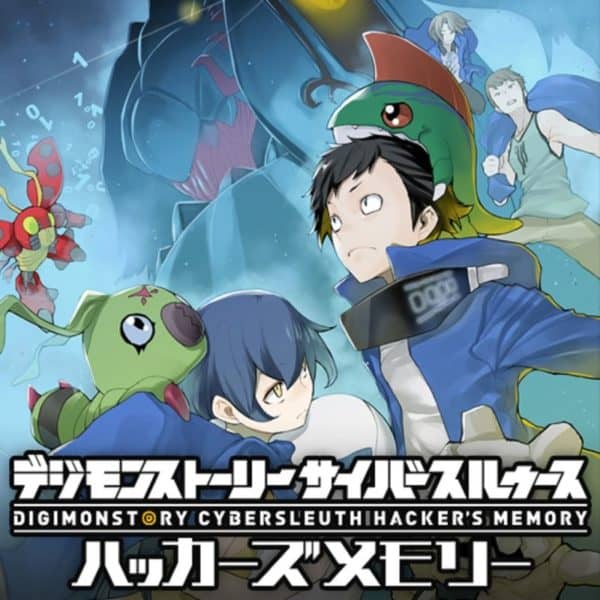
Title: Digimon Story Cyber Sleuth: Hackers Memory
Platform: PS4 [Reviewed], PS Vita
Genre: Japanese Role-Playing Game
Developer: Media.Vision
Publisher: Bandai Namco
Players: 1
Release Date: January 19, 2018
Price: $59.99
* Editors Note: Due to this website not existing prior to the initial release of the first Cyber Sleuth game, we don’t have a review of the game for you to read. For that reason, I’ll be doing more explaining of the game mechanics than what you’ll find on other sites for reviews of Hacker’s Memory. Honestly, Hacker’s Memory takes the majority of its mechanics from the first title. So, at times this may feel more like I’m reviewing both games together, outside of the story. Just because I feel that its owed to readers of our site, and for any newcomers to the series. If you are someone that’s rather familiar with the first title, use our subheadings in the review accordingly. *
Not Just Another Side Story
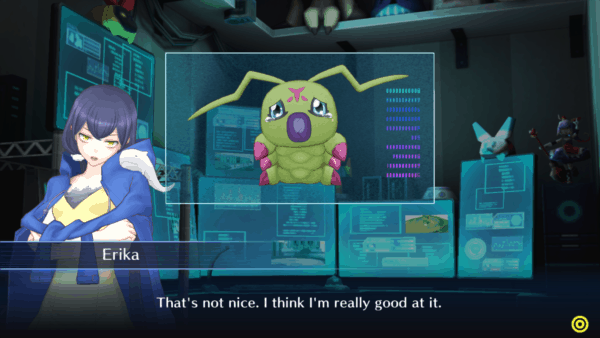
The major difference of note between the two games is their stories. While Cyber Sleuth was more of a save the world narrative told through the conceit of being a cyber detective, Hacker’s Memory is much more personal. Although, it kinda has to be, since it literally plays out alongside the first game. In fact, many characters appear at random times from the first game, without much warning. So, if you are coming into Hacker’s Memory fresh, you may feel very lost. Although, being a side story, several characters like Yuuko and Detective Matayoshi have more of their personalities fleshed out in Hackers Memory, than they did in the original Cyber Sleuth.
If you played the first game, the cameos, hints, and reveals of old characters are mostly a nice treat. But the game does feel like it expects you to know a lot about what happened previously, which isn’t very friendly because we are talking about two 40 + hour games here. That being said, Hackers Memory has deeper character development, which helps set it apart.
Getting Involved
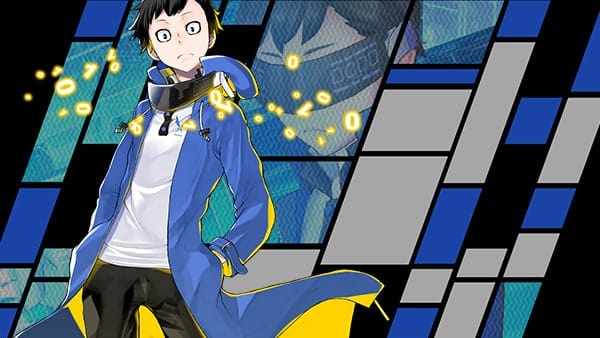
Hacker’s Memory places you in the shoes of Keisuke Amazawa who’s had his EDEN account stolen, and is essentially outcasted due to being charged with a crime he didn’t commit. Keisuke joins a hacker group called Hudie to try to get back his lost account and prove his innocence. For those uninitiated, EDEN is a virtual cyberspace where people can work, interact, and play all with real walking avatars. As with anything, there’s always someone that doesn’t exactly want to play by the rules.
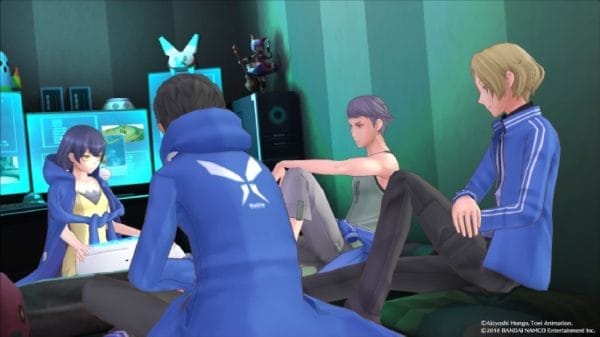
While Hackers Memory does have some of the overarching narratives from the original, such as Rie still having involvement, Yuugo and Fei making appearances, along with many others. It is largely centered around dealing with other hacker groups, seeing as Hudie is the group for hire when it comes to dealing out cyber justice. So, you’ll see a lot of Ryuji Mishima Chitose Imai and Erika Mishima. They each have their own personality traits that grow as the story goes further into chapters. Erika, in particular, has a huge reveal early in the story, which gives a nice emotional gravitas to the proceedings. While also setting in motion why many things happen to the group.
A Slower Pace
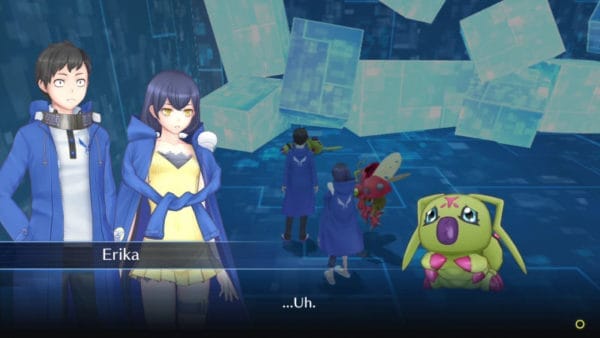
The only issue I had with the story is that it felt a lot slower moving than the one in the first game. Due to what I mentioned earlier, Hudie is given a lot of sidequests to complete since they are ridding Kowloon of evil hacker groups and people that want to use Digimon as their slaves. This also includes having Digimon for sale at the DigiMart, which you can also access as well. While DigiLab attendant Mirei still wants you to complete her list of 30 hackers, the mundane Digimon fetch quests from Cyber Sleuth are gone.
However, in its place are shorter “take out random hacker” missions. And, longer “important” sidequests which force Keisuke and the squad to go to various places in EDEN or the real world, find the source of the problem, and remove it. While some of these missions are kind of interesting, they do feel like unnecessary extra padding. Especially when you’ve just gotten through a big reveal in the main story. Only to have to do two or three sidequests, just so you can get to the next story beat. Making most of these entirely optional may have helped smooth the story pace a bit more.
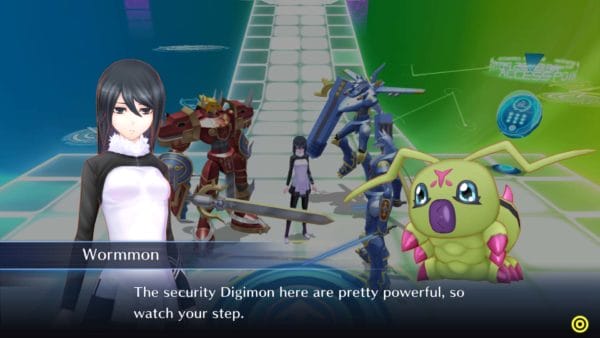
That being said, I found the story in Hackers Memory a lot more enjoyable than the original Cyber Sleuth. Especially, once each Hudie member starts getting payoffs in the latter stages of the game. And I’d probably feel that way without having played the first game. Especially because Erika’s character alone is much more endearing than any one character from Cyber Sleuth was. Both games stories are worth going through, but if I had to only pick one, my vote would go towards Hacker’s Memory. What I liked the most is that even though the game certainly has its serious moments. It also found time to add-in jokes and some of anime type comedy to keep other moments light.
Get Ready For Some Reading
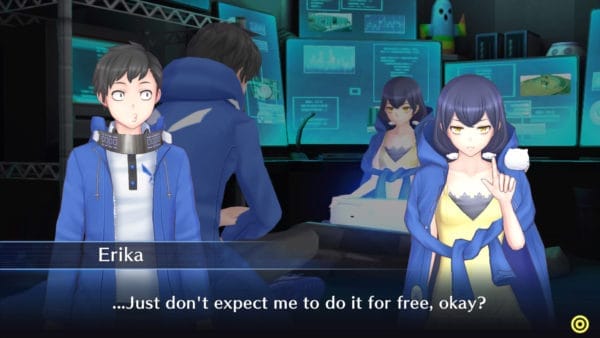
I also should note that much like original Cyber Sleuth, Hacker’s Memory is still all voiced in Japanese with English subtitles. So, if you are one of those that doesn’t like playing games in other languages, be forewarned. I watch anime subbed all the time. So this isn’t a personal problem for me at all, but I know there are those that may find this a big hang-up. In fact, compounding the issue is that it feels like there’s, even more, talking in this story, than in the first game, which also adds to the slower pace. Sometimes it feels like certain chapters border on visual novel levels of text. While others don’t have that much at all.
Something Feels Very Familiar
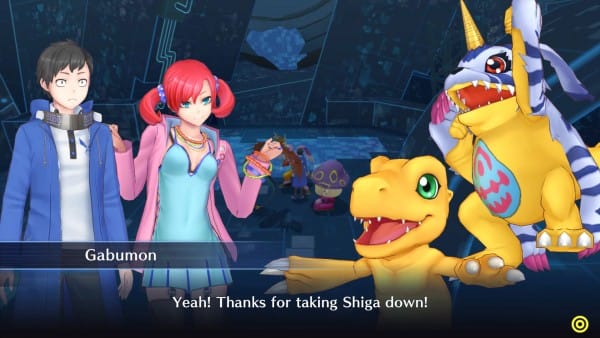
Aside from one new form of battling, which I’ll get to a little later, everything else about Hackers Memory is going to feel eerily similar. For returning players, you’ll even get the option of importing your save from Cyber Sleuth. Giving you some extra bonus items. Most importantly, and the major reason why I think this is a great decision, is it imports your Digi-Bestiary as well. So, this makes digivolving a whole lot easier the second time around. Since you’ll know most of the Digimon forms available, there’s more choice, and less guessing in constructing your Digi-Squad. I can’t tell you how many times I had to go use a Digimon Wiki page to play “who’s that Digimon?” in the shadow thumbnail. It was a nice relief that Hacker’s Memory gave me way less of that.
However, new players should be ready to have to do a lot of reading in menus or on the internet, because Hacker’s Memory isn’t too keen on teaching you the basics. As previously mentioned, it expects that you’ve played the original game, and only new mechanics or more advanced things receive explained tutorials.
Simple Yet Deep Combat
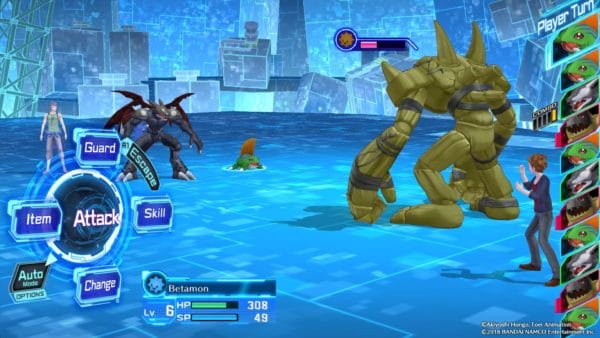
The Cyber Sleuth games don’t employ anything you haven’t seen in other RPG’s, but how they make it work is what shines through. The player and opponent take turns dealing out damage. Once all three opposing Digimon is defeated, the battle ends. On the right side of the screen, there’s a graphic that shows the turn order. Turn order is determined by a Digimon’s speed or by outranking the opposing Digimon in digivolution. For example, any Champion level Digimon are going to outrank any Rookie level and below Digimon. If you are the same evolution level, this is when speed comes into play.
Providing the rock-paper-scissors system of one type outdoing another serves as the base of the battle system. Digimon have three main types, Vaccine, Virus, and Data. While also adding the neutral type, giving even more variety in battle. On top of the types, come nine elements, which add extra damage. For example, vaccine type Digimon are super effective against virus type. Usually, that’s enough to gain a big advantage in normal battles. But if you want boss battles to go a bit smoother, you may wanna key in on an elemental advantage as well.
These also go against you, so the best way to combat this is by keeping a balanced party around. However, they don’t have to be one of three initially sent into battle. Since you can switch between party members and reserves at will like Pokemon. The difference here is, you actually can control how many Digimon are in your entire party at once. Although, just as important is making sure you match enemies in digivolution level. You don’t want to have a party full of Rookie Digimon. Then, go on a quest and the majority of the wild Digimon wind up being Champion level. This puts you at an almost impossible disadvantage. Forcing you to make a trip into the DigiLab.
Enter the DigiLab
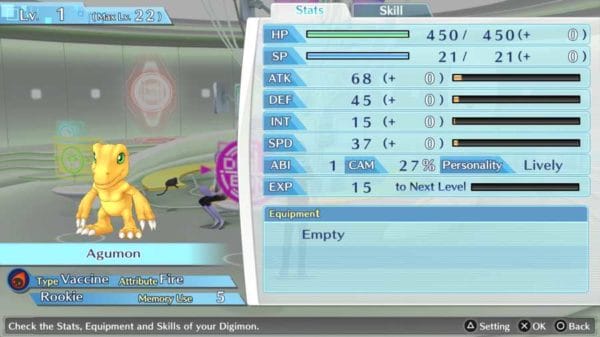
Hopefully, players like the scenery here, because get ready to spend a lot of time in the DigiLab. Being made of data, Digimon don’t just have one evolutionary line. They have multiple ways of digivolving into stronger forms. While also frequently de-digivolving back to lower forms for various reasons. The Cyber Sleuth games follow this concept very well. Making raising, evolving and caring for Digimon just as enjoyable, if not more so, than other monster games.

Players begin by choosing one Digimon out of three possibilities. Tentomon Izzy’s Digimon from the Adventure 01-02 anime. Betamon he makes some appearances in the Adventure 02 anime with Michael. There’s also Gatsumon who appears in probably all of the anime seasons at least once. After that, you get more Digimon by finding them in battle. Before a battle begins a number with a percentage appears on the screen. This is an auto scan which keeps its own tally for every Digimon you encounter. Once you get to 100 percent you can go into the DigiLab and DigiConvert them. However, you may want to wait until they go beyond that say 150 or their MAX amount of 200 percent. By doing this, the Digimon begin with much better stats and you don’t have to do as much grinding in digivolving them.
The DigiFarm Lessens Grinding
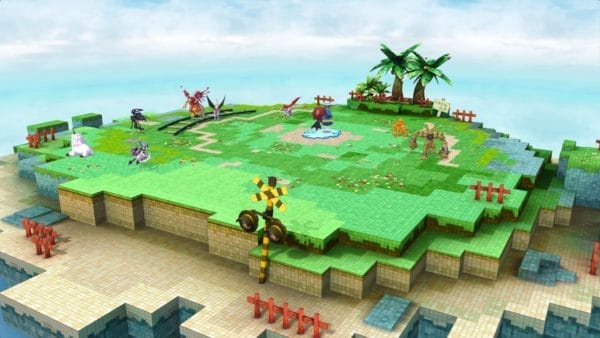
The DigiLab, scanning, and the DigiFarm were all introduced starting with 2005’s Digimon World DS and smartly carried over to these games. The DigiFarm is important for several reasons. Firstly, unlike Pokemon, you control the amount of Digimon in your party at one time. Each Digimon form (Baby, In-Training, Rookie, Champion, Ultimate, and Mega) all have their weight, which is given out in points. You begin with a limit of 30 points and then raise that slowly by finding Memory Up chips. These are either in Item Boxes or found by completing missions. As the Digimon get stronger, they gain points, so players need to always have a backup plan before digivolving.
This is easily completed with the help of the DigiFarm. Think of it as a more interactive version of the Poke’ Breeder. Due to the party limit, any Digimon you DigiConvert need to keep growing. Eventually, you’ll get so many Digimon that you won’t be able to grow all of them, but you can always switch them out freely. The DigiFarm doesn’t go by points, but just by a pre-set 10 spots. So, as long as you have an open slot, you can put a Digimon of any evolution level in it. While in the DigiFarm, Digimon gain levels on their own. Allowing players to continue playing the game with their party members, and then check-in whenever they’d like.
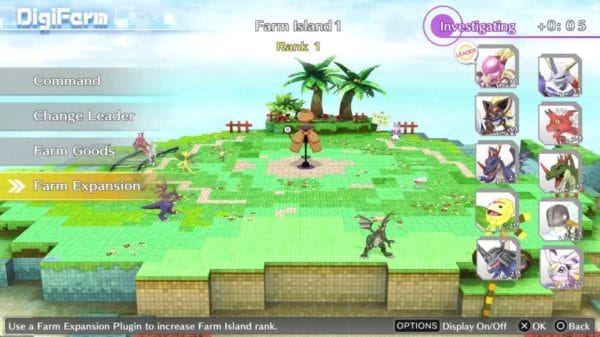
Players can also upgrade the DigiFarm up to five levels. This is done with Farm Expansion chips that are gained by completing certain missions, or by finding them in Item Boxes. Upgrading helps in gaining special items found by Digimon on the farm. You can also use the farm for investigation purposes. This helps add more sidequests to the list. Finally, later in the game, you’ll be able to add more total farms. Increasing the amount of Digimon you can train at one time. You can have up to four different DigiFarm’s in the game.
Digivolving and De-digivolving
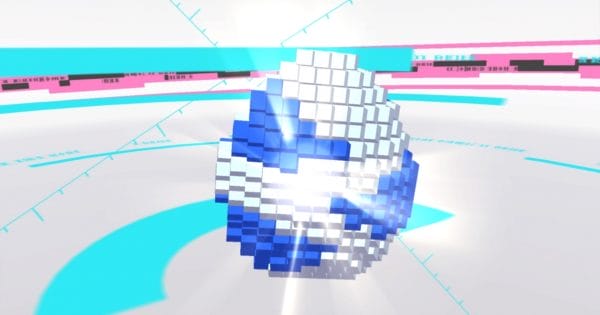
Baby to Rookie Digimon gain levels pretty fast. So, if you are trying to get a specific Digimon early on in development, you may wanna check-in to the DigiLab more frequently. Once they get to the Champion level and beyond, they gain levels much slower. Also, the Digimon won’t digivolve on their own there. So, you do need to keep track of their Digivolve levels, max levels, and certain stats. Then, figure out what Digimon you want them to become, and watch them digivolve. However, as I explained earlier, Digimon don’t have a set evolutionary track. So digivolving isn’t just about getting them to level 18 or level 36 and watching the magic happen. They may need certain special stats in order to get the Digimon you want.
It may be something as easy as pushing them over the required Level 30, and waiting until their Attack stat is high enough at Level 35, or it could be something a little more time-consuming. Two stats, in particular, are very important. Especially if you want some of your favorite Digimon from the anime to follow their digivolutions from those shows.
CAM & ABI
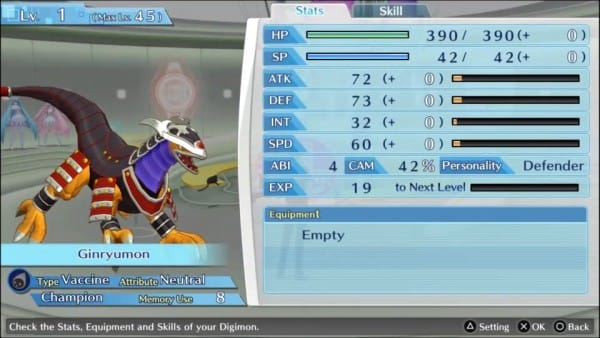
For instance, many of them require the CAM stat to be at a certain percentage. For Rookies, this could be 10%, but for Champions it may rise to 50%, even go into the full 100% for true Mega forms. CAM is only gained by using a Digimon in battle, and they actually have to be on the field. They cannot simply be in the reserves. 1 CAM is gained per battle. So, you can figure out what that means for trying to get the higher digivolutions.
The other important stat is the ABI. At least 20 ABI is required for digivolution to any Mega form. While special Digimon may require even more. For example, if you wanna run around with a Diaboromon from Digimon: The Movie he requires 40 ABI. Whereas there are ways to gain CAM outside of battle with an item called “Friendship” or by feeding Digimon various kinds of DigiMeat at the DigiFarm.
ABI is only gained through digivolving and de-digivolving. Also, because there are so many digivolutions for each Digimon, every time they digivolve their level goes back to 1. So, if you are planning on getting certain Digimon to Mega, you may want to go ahead and de-digivolve all the way down to Baby form and then have them work their way up. This is the case for every single Digimon you want to digivolve all the way, even your starter Digimon should go through a de-digivolution at some point.
The Key Lies in Quests
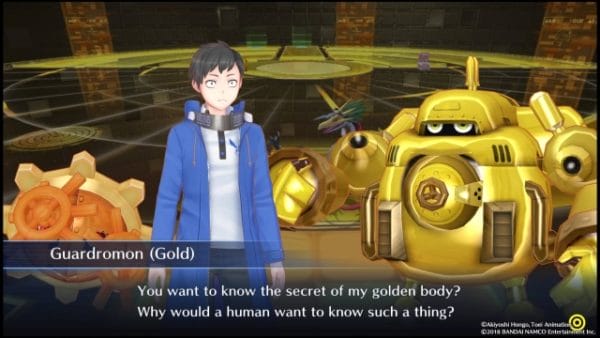
Earlier I mentioned that the game forces you into quite a lot of sidequests. Well, the Digimon are a good reason for that. When actually on a quest, unless it is a longer story quest requiring you to go through multiple levels of a special area, you don’t actually run into a lot of random encounters. Most of the shorter quests also take place in either Kowloon or Under Kowloon. These are rife with In-Training to Rookie level Digimon. Meaning if you have higher evolved Digimon, it may not help much.
So, the game pushes many different quests at you, not just for the story, but also so that by close to the end, you actually have a chance of having multiple Mega level Digimon. Although, if you follow the de-digivolving stuff I talked about above, it is possible that by Chapter 6 or 7 you might start getting some.
The Final Word on Gameplay
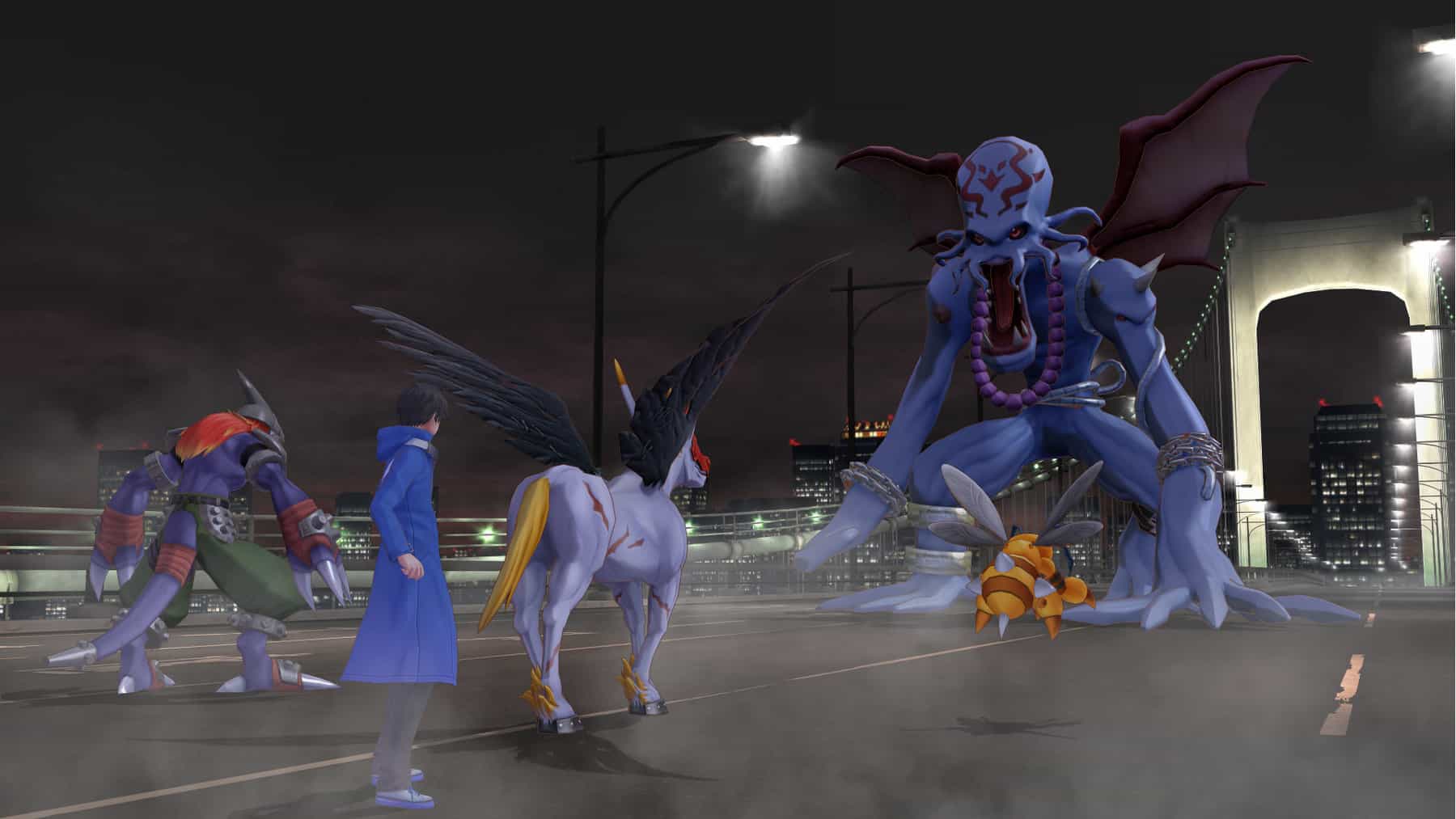
Overall, for me, this is where these games shine best. Having so much variety in how you can digivolve the Digimon is super important. The de-digivolving may create a grind that not everyone is going to enjoy, but this is what opens the door for you to constantly be thinking of others you’d like to add to the party. Having multiple backups is never a bad thing. The memory point system may also be a drag for some, but once again it forces you to make decisions.
There’s 340 Digimon in Hacker’s Memory and I truly wanted to keep discovering more of them. Something that I feel has become almost completely lost in the Pokemon series. No matter how many times you DigiConvert a certain Digimon, the game is always scanning. Always keeping you thinking about another Digimon you could raise.
However, none of this would work if it wasn’t for the battle system. Honestly, most of the battles are absolute cakewalks, which really makes some of the shorter quests annoying. But when you are surprised by a mismatch in type, or by a difficult boss, the depth is put to the test.
Domination Battles
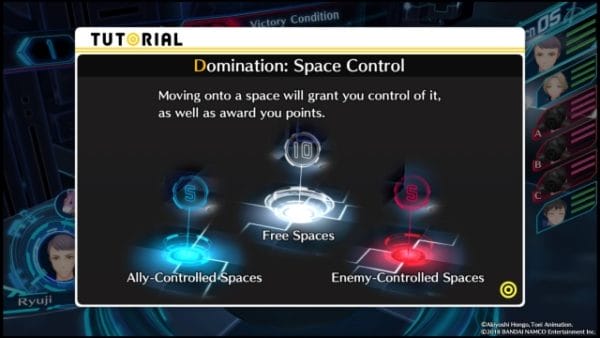
Speaking of quests, several of the shorter and even some longer ones simply exist so that you participate in Hacker’s Memory separate form of battling. These are called Domination Battles. Domination Battles simply just add an extra layer and a different mechanic to the battle system. Basically, it’s a game of Chess. Each team must have three members. Also, each team member is controlled separately.
Domination Battles have only two modifiers. Gain a certain number of points, or gain a certain number of points by an exact amount of turns. The modifier with the turns is a little harder, and I actually lost once because I didn’t pay attention to the turn count. However, by-in-large these battles are fairly easy. So long as you maintain a balanced party, you’ll be fine. Personally, because I like to bring with me various Digimon from the anime, most of them are Vaccine Digimon, so if your opponents have all Data Digimon, you may get into some trouble. This is because Domination Battles are a strategy game.
More on Domination Battles
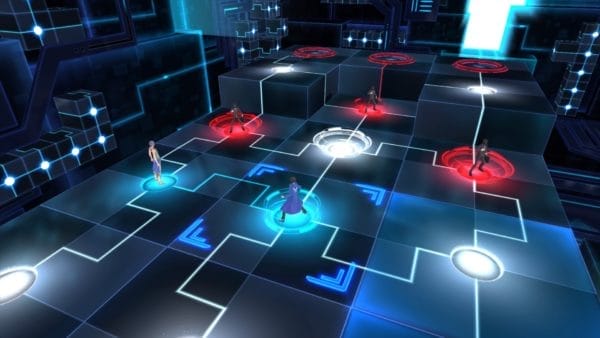
So, each square at least counts towards one point. If your team member has touched it, it turns blue. If an opponent touches it, it turns red. There are also special squares which have a “5” or “10” over them. These are there to give each side a chance to turn the tide of battle fast. Most of the time, these are also where the battles are concentrated. Since everyone gets a turn, each Digimon in a party gets one chance to attack.
After that, the battle ends. You are not allowed to use items on your Digimon, although you can use healing abilities in battle. If you are able to knock out all the Digimon from one character, they are gone for an entire turn. Then reappear at the back of the grid. This gives you a short numerical advantage. And a chance to grab some extra points without running into a battle. Once you gain the necessary points, you win.
This is really the only thing Hackers Memory brings that’s new on the gameplay front. Ultimately, there’s just not enough Domination Battles in the game to make it feel like a necessary component. They feel almost like something added to test the audience’s reception towards them, more than because they bring something to the table. Not to mention, unless you get caught completely unprepared Digimon wise, there’s no challenge in these battles at all. I mean, in fairness the whole game is kind of like that in general. However, for being something new, these just didn’t do much for me.
Traveling Through EDEN & Japan
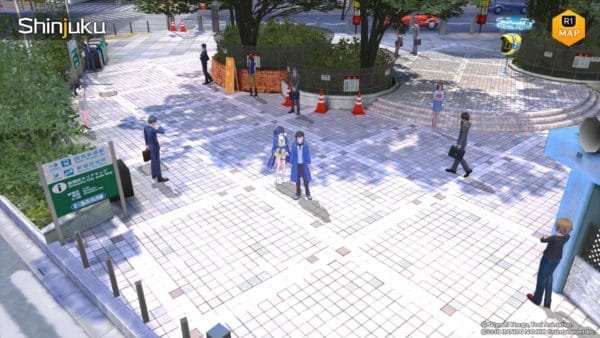
The Cyber Sleuth games are set in Japan, and players actually visit sectioned off versions of real cities. Shibuya, Shinjuku, Akihabara are all represented here. While the first game was set mostly in Nakano Broadway. Hacker’s Memory places Hudie headquarters in Ikebukuro. Traveling around cities is more akin to the Persona or Akiba games. It is far from an open world and you only explore small sections of each city. With each place having a few important landmarks that Keisuke and co. can actually go into. The real world is honestly just there to quickly get you where you need to go.
Although, the missions don’t necessarily do the best job of telling you where to go. Sometimes I even had to go into the DigiLab and talk to Mirei, to find out the quest’s location. Even though the quest had nothing to do with her at all. Speaking of missions, all of them are selected by going inside Hudie HQ, turning on the PC, and going to the virtual bulletin board. This is also where you can visit the DigiLab, read hacker memories, which some of them are important for unlocking certain Mega Digimon.
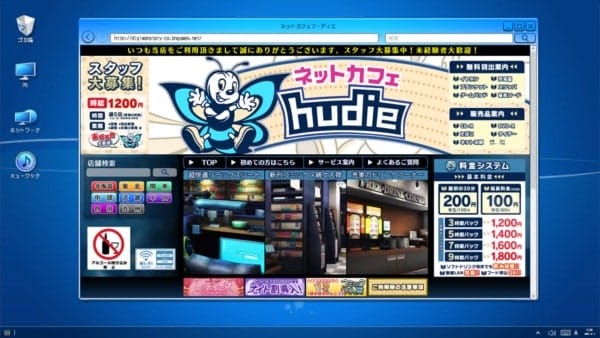
Unless you are doing a cross-world mission, most of your time is spent inside EDEN. All Domination Battles and Digimon Battles take place here. The game’s biggest high points also occur here. But the issue is, you may get tired of looking at it after a while. The dungeons and areas are all largely the same between both games. Hacker’s Memory tries to add different color palettes to some sidequest dungeons, but that’s the extent of it really.
Camera, Characters, and Music

The biggest problem with the design of both games is the fixed camera. Traversing both EDEN and the real world suffers greatly because you can hardly move the camera. In the real world, it just leads to walking around until you find an area that lets you go down a street. In EDEN, this can make hacker quests problematic. First of all, the minimap is just as closed in, as you are. So, many times you won’t know there are multiple exits or entrances into another area until you’ve already passed it. Once you go through these areas a few times it won’t be a big deal because you’ll already know it. The minimap does do a great job in showing you the item boxes in each area. So, you can easily find the loot.
However, there is no waypoint system or any kind of marker to tell you where in the dungeon to go, which really is fine 90% of the time. The other 10% can make finding this specific hacker you need an absolute chore. Several times I went into each area of a dungeon searching for the NPC with the exclamation point on his head. It wasn’t until I started making my way back that I could see my target. The camera was so zoomed in I had missed him by a mile. This happened quite a few times, and it is absolutely annoying.
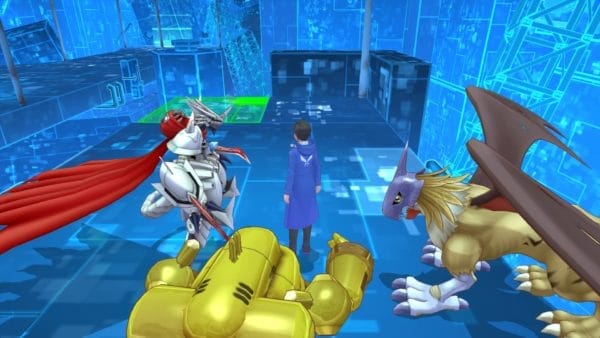
Camera issues aside, the game is at its best when focusing on characters or Digimon. The Digimon all look great, the battle animations have been improved some over Cyber Sleuth as well. Characters emote well in Japanese and the voice cast is pretty strong for the most part. Another similarity with the first game is its soundtrack. Masafumi Takada does bring in some new tracks to the memorable techno-pop tunes. But for the most part, it is largely the same, which isn’t particularly a bad thing because the soundtrack is pretty good. Although, you’ll probably get tired of the battle theme after a while.
Pros
Raising, Digivolving and Battling with Digimon is the best
The Story has some deep themes and is more personal
Characters are more fleshed out than in the original
Digimon still look great, and battle animations are improved
Soundtrack although completely carried over, is still good
Cons
Domination Battles are too easy, and there’s not enough of them either
The fixed camera can make exploring a chore
Outside of the Digimon, graphics are a bit lacking
A lot of recycling from the first game
Overall the game may still be a bit too easy
Final Thoughts
Overall Score: 7.5 Out of 10 Digimon Story Cyber Sleuth: Hacker’s Memory recycles a lot from its predecessor. In one way, you can’t blame Media.Vision and Bandai Namco for making sure they get something out of a side story to the best game the Digimon series has ever released. Honestly, the first game brought with it a lot of good things, they aren’t the first to try to develop a winning formula. However, the one new game mechanic brought into Hacker’s Memory is rather lacking. And the design flaws also make it even more apparent these games were made with the PlayStation Vita in mind first, with the PS4 second.
However, as a package, Hacker’s Memory is still a very solid RPG with a terrific story, albeit on the dense side in both length and literature. This series is still the most fun I’ve ever had with Digimon games. They absolutely do the anime justice in so many ways. It’s a joy to train Digimon, digivolve them, and then watch them perform in battle. Let’s just hope the next game can innovate a little more, and bring a better challenge for hardcore fans of the series. Big Digimon fans probably already own the title, but if you played the first game, and you are on the fence, maybe wait until it goes down to half price. Either way, once again Media.Vision and Bandai Namco make a damn good Digimon game.
This game was reviewed using a digital code provided by the publisher Bandai Namco.
